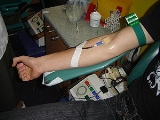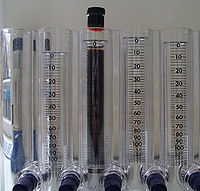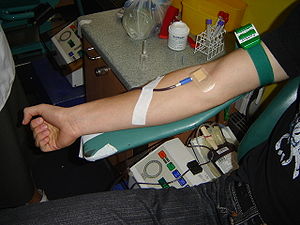
New Zealand Blood Service
Encyclopedia
The New Zealand Blood Service (NZBS) is the body primarily responsible for blood donation and related services in New Zealand
.
Unlike its Australian counterpart
, the NZBS is a service operated by the New Zealand Government, not the New Zealand Red Cross
.
needed to help in a variety of ways. The NZBS was formed under the guidelines of the World Health Organisation (WHO) on the collection and clinical use and distribution of blood.
Approximately 42,000 New Zealanders need blood or blood products every year and 4% of New Zealanders donate.
 The NZBS collects more than 150,000 whole blood donations per year, 23,000 apheresis plasma donations and 6,000 apheresis platelet donations to meet the requirements of the New Zealand Health Care System. Whole blood donations are separated in 3 components - Red blood cell
The NZBS collects more than 150,000 whole blood donations per year, 23,000 apheresis plasma donations and 6,000 apheresis platelet donations to meet the requirements of the New Zealand Health Care System. Whole blood donations are separated in 3 components - Red blood cell
s, blood plasma
and platelet
s.
To ensure that the blood is safe for the patient and the blood donation process is safe, donors are screened each time before donating to eliminate potential risks. Blood donations themselves are tested for diseases such as Hepatitis B, Hepatitis C
, HIV
, AIDS
and HTLV-1
. No reliable tests exist for Creutzfeldt–Jakob disease (CJD) so donations are not accepted from persons who have lived in CJD affected areas such as the United Kingdom
, France
or the Republic of Ireland
between 1980 and 1996.
The New Zealand Blood Service has over the past years, developed close working relations with similar organizations such as:
This is because these countries are "geographically close in either proximity or terrain" and face similar challenges in blood collecting, testing and distribution. The NZBS also modelled itself after the National Blood Service
(NBS
) in England
and learnt through its revolutionary and evolutionary changes and providing the best methods for delivery of services.
 The NZBS visits high schools, community centres and businesses in towns all over New Zealand
The NZBS visits high schools, community centres and businesses in towns all over New Zealand
and appeals to all eligible donors to give blood. Donations from mobile collections account for approximately 50% of the blood collected, with the other 50% collected at the donor centres.
Donor Centres are present at 6 main locations across the country, with 3 centres in Auckland
, and one each in Hamilton
, Palmerston North
, Wellington
, Dunedin
and Christchurch
. There are also smaller donor centres in Napier
, Tauranga
, and Nelson
, with mobile collection sites available to be set up in community centres around the rest of the country.
They also offer a shuttle service to transport donors during blood drives held at various places like school halls and convention centres in towns and cities across New Zealand.
The NZBS also travel to businesses who agree to let NZBS to collect blood from workers through special venues established by both the employer and the NZBS.
New Zealand
New Zealand is an island country in the south-western Pacific Ocean comprising two main landmasses and numerous smaller islands. The country is situated some east of Australia across the Tasman Sea, and roughly south of the Pacific island nations of New Caledonia, Fiji, and Tonga...
.
Unlike its Australian counterpart
Australian Red Cross Blood Service
The Australian Red Cross Blood Service is a branch of the Australian Red Cross. It is the body primarily responsible for blood donation and related services in Australia.-History:...
, the NZBS is a service operated by the New Zealand Government, not the New Zealand Red Cross
New Zealand Red Cross
The New Zealand Red Cross was created by nurse Beth Charpentier in 1914 shortly after the beginning of World War I generally for the purpose of responding to natural disasters or man-made disasters and also helping out vulnerable or needy people both in New Zealand and abroad.The organization is...
.
History
The New Zealand Blood Service was formed on 1 July 1998 with the primary responsibility of gathering and maintaining safe levels of bloodBlood
Blood is a specialized bodily fluid in animals that delivers necessary substances such as nutrients and oxygen to the cells and transports metabolic waste products away from those same cells....
needed to help in a variety of ways. The NZBS was formed under the guidelines of the World Health Organisation (WHO) on the collection and clinical use and distribution of blood.
Approximately 42,000 New Zealanders need blood or blood products every year and 4% of New Zealanders donate.
Duties

Red blood cell
Red blood cells are the most common type of blood cell and the vertebrate organism's principal means of delivering oxygen to the body tissues via the blood flow through the circulatory system...
s, blood plasma
Blood plasma
Blood plasma is the straw-colored liquid component of blood in which the blood cells in whole blood are normally suspended. It makes up about 55% of the total blood volume. It is the intravascular fluid part of extracellular fluid...
and platelet
Platelet
Platelets, or thrombocytes , are small,irregularly shaped clear cell fragments , 2–3 µm in diameter, which are derived from fragmentation of precursor megakaryocytes. The average lifespan of a platelet is normally just 5 to 9 days...
s.
To ensure that the blood is safe for the patient and the blood donation process is safe, donors are screened each time before donating to eliminate potential risks. Blood donations themselves are tested for diseases such as Hepatitis B, Hepatitis C
Hepatitis C
Hepatitis C is an infectious disease primarily affecting the liver, caused by the hepatitis C virus . The infection is often asymptomatic, but chronic infection can lead to scarring of the liver and ultimately to cirrhosis, which is generally apparent after many years...
, HIV
HIV
Human immunodeficiency virus is a lentivirus that causes acquired immunodeficiency syndrome , a condition in humans in which progressive failure of the immune system allows life-threatening opportunistic infections and cancers to thrive...
, AIDS
AIDS
Acquired immune deficiency syndrome or acquired immunodeficiency syndrome is a disease of the human immune system caused by the human immunodeficiency virus...
and HTLV-1
Human T-lymphotropic virus
Human T-cell Lymphotropic Virus Type 1 , also called the Adult T-cell lymphoma virus type 1, a virus that has been seriously implicated in several kinds of diseases including HTLV-I-associated myelopathy, Strongyloides stercoralis hyper-infection, and a virus cancer link for leukemia...
. No reliable tests exist for Creutzfeldt–Jakob disease (CJD) so donations are not accepted from persons who have lived in CJD affected areas such as the United Kingdom
United Kingdom
The United Kingdom of Great Britain and Northern IrelandIn the United Kingdom and Dependencies, other languages have been officially recognised as legitimate autochthonous languages under the European Charter for Regional or Minority Languages...
, France
France
The French Republic , The French Republic , The French Republic , (commonly known as France , is a unitary semi-presidential republic in Western Europe with several overseas territories and islands located on other continents and in the Indian, Pacific, and Atlantic oceans. Metropolitan France...
or the Republic of Ireland
Republic of Ireland
Ireland , described as the Republic of Ireland , is a sovereign state in Europe occupying approximately five-sixths of the island of the same name. Its capital is Dublin. Ireland, which had a population of 4.58 million in 2011, is a constitutional republic governed as a parliamentary democracy,...
between 1980 and 1996.
The New Zealand Blood Service has over the past years, developed close working relations with similar organizations such as:
- The Australian Red Cross Blood ServiceAustralian Red Cross Blood ServiceThe Australian Red Cross Blood Service is a branch of the Australian Red Cross. It is the body primarily responsible for blood donation and related services in Australia.-History:...
- The Scottish National Blood Transfusion ServiceScottish National Blood Transfusion ServiceThe Scottish National Blood Transfusion Service is the national blood, blood product and tissue provider of Scotland. It is a special health board of the Scottish National Health Service.-History:...
- and The Finnish Red Cross Blood Service
This is because these countries are "geographically close in either proximity or terrain" and face similar challenges in blood collecting, testing and distribution. The NZBS also modelled itself after the National Blood Service
National Blood Service
The National Blood Service is the organisation for England and North Wales which collects blood and other tissues, tests, processes, and supplies all the hospitals in England and North Wales...
(NBS
National Blood Service
The National Blood Service is the organisation for England and North Wales which collects blood and other tissues, tests, processes, and supplies all the hospitals in England and North Wales...
) in England
England
England is a country that is part of the United Kingdom. It shares land borders with Scotland to the north and Wales to the west; the Irish Sea is to the north west, the Celtic Sea to the south west, with the North Sea to the east and the English Channel to the south separating it from continental...
and learnt through its revolutionary and evolutionary changes and providing the best methods for delivery of services.
- NZBS is the appointed body for all New Zealand blood.
- NZBS is the organization who is responsible for all donations and distribution of blood in New Zealand, nationally; New Zealand's blood service is based on a voluntary basis and unpaid donations.
- NZBS is responsible for all blood from collection to distribution and for other controlled human tissues.
- NZBS is a not-for-profit Crown Agency responsible to the Ministry of Health
Blood collection

New Zealand
New Zealand is an island country in the south-western Pacific Ocean comprising two main landmasses and numerous smaller islands. The country is situated some east of Australia across the Tasman Sea, and roughly south of the Pacific island nations of New Caledonia, Fiji, and Tonga...
and appeals to all eligible donors to give blood. Donations from mobile collections account for approximately 50% of the blood collected, with the other 50% collected at the donor centres.
Donor Centres are present at 6 main locations across the country, with 3 centres in Auckland
Auckland
The Auckland metropolitan area , in the North Island of New Zealand, is the largest and most populous urban area in the country with residents, percent of the country's population. Auckland also has the largest Polynesian population of any city in the world...
, and one each in Hamilton
Hamilton, New Zealand
Hamilton is the centre of New Zealand's fourth largest urban area, and Hamilton City is the country's fourth largest territorial authority. Hamilton is in the Waikato Region of the North Island, approximately south of Auckland...
, Palmerston North
Palmerston North
Palmerston North is the main city of the Manawatu-Wanganui region of the North Island of New Zealand. It is an inland city with a population of and is the country's seventh largest city and eighth largest urban area. Palmerston North is located in the eastern Manawatu Plains near the north bank...
, Wellington
Wellington
Wellington is the capital city and third most populous urban area of New Zealand, although it is likely to have surpassed Christchurch due to the exodus following the Canterbury Earthquake. It is at the southwestern tip of the North Island, between Cook Strait and the Rimutaka Range...
, Dunedin
Dunedin
Dunedin is the second-largest city in the South Island of New Zealand, and the principal city of the Otago Region. It is considered to be one of the four main urban centres of New Zealand for historic, cultural, and geographic reasons. Dunedin was the largest city by territorial land area until...
and Christchurch
Christchurch
Christchurch is the largest city in the South Island of New Zealand, and the country's second-largest urban area after Auckland. It lies one third of the way down the South Island's east coast, just north of Banks Peninsula which itself, since 2006, lies within the formal limits of...
. There are also smaller donor centres in Napier
Napier, New Zealand
Napier is a New Zealand city with a seaport, located in Hawke's Bay on the eastern coast of the North Island. The population of Napier is about About 18 kilometres south of Napier is the inland city of Hastings. These two neighboring cities are often called "The Twin Cities" or "The Bay Cities"...
, Tauranga
Tauranga
Tauranga is the most populous city in the Bay of Plenty region, in the North Island of New Zealand.It was settled by Europeans in the early 19th century and was constituted as a city in 1963...
, and Nelson
Nelson
- People :* Horatio Nelson, 1st Viscount Nelson, English admiral* Nelson , for other people with the surname "Nelson"* Nelson , for people with the given name "Nelson"...
, with mobile collection sites available to be set up in community centres around the rest of the country.
They also offer a shuttle service to transport donors during blood drives held at various places like school halls and convention centres in towns and cities across New Zealand.
The NZBS also travel to businesses who agree to let NZBS to collect blood from workers through special venues established by both the employer and the NZBS.

